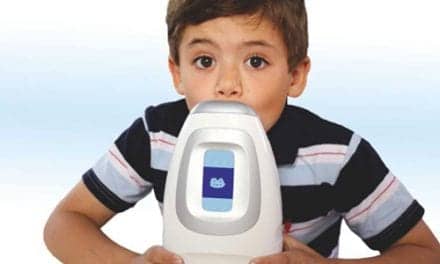 Impulse oscillometry, an alternative to conventional spirometry, requires only a few normal breaths for a complete test and so can be especially effective in pediatric and geriatric patient populations, according to David Sinks, director, technical marketing, for VIASYS Healthcare, Yorba Linda, Calif. RT spoke with Sinks to find out more about how impulse oscillometry can be a valuable resource for RTs and patients. Impulse oscillometry, an alternative to conventional spirometry, requires only a few normal breaths for a complete test and so can be especially effective in pediatric and geriatric patient populations, according to David Sinks, director, technical marketing, for VIASYS Healthcare, Yorba Linda, Calif. RT spoke with Sinks to find out more about how impulse oscillometry can be a valuable resource for RTs and patients.
Q: What are the main differences between impulse oscillometry and spirometry?
A: Impulse oscillometry (IOS) is measured during quiet breathing and requires very little patient cooperation during the passive measurement. Gentle pulses of air are superimposed upon the normal resting breathing of subjects, and the resultant changes in airway pressure and flow are detected and analyzed in real time and presented to the respiratory care practitioner. Airway resistance is computed for multiple frequencies, which can be used to evaluate central and peripheral airways. Oscillatory resistance measures can extend the range of pulmonary function testing to children who may be unable to perform a standard flow-volume loop. Response to a bronchodilator medication can be evaluated by a reduction in measured resistance during normal quiet breathing. Respiratory impedance measurements can be performed in older patients as well to evaluate bronchodilator responsiveness and bronchial hyper-reactivity/challenge testing. The requirement for repeated flow-volume loop maneuvers to evaluate the effect of bronchoconstrictive agents may be tiring for some patients. The need to fully inspire to total lung capacity to begin the flow-volume loop may add an additional bronchial dilator effect from the deep inhalation, offsetting some the provocation effects. The deep breath may cause other patients to air trap, and the exhalation to residual volume may also be fatiguing. While the replacement of oscillatory mechanics (Rrs) measurements for the spirometric (PC-20 [FEV1]) evaluation of bronchial hyper-responsiveness is unlikely, monitoring the change in oscillatory mechanics during tidal breathing at intervals during the administration of the provocative agent, followed by the measurement of spirometry when there is a significant increase in resistance, may be an acceptable method for those patients in whom fatigue is present.
Q: When is the use of IOS most appropriate and why?
A: Oscillatory mechanics made during quiet breathing may be helpful to follow changes in airway caliber during treatment for asthma and other respiratory diseases. Reference values have been proposed in a European Respiratory Society document. There is a second document in preparation for clinical application of oscillatory mechanics for children.
Q: What else should RTs know about the IOS technique?
A: Reimbursement for the oscillatory mechanics measurement is available using the CPT Code 94360, “Determination of resistance to airflow, oscillatory or plethysmographic methods.” Our training program for IOS has been approved for 9 hours of Continuing Respiratory Care Education CEUs.
References
1. Goldman MD. Clinical applications of forced oscillation. Pulm Pharmacol Ther. 2001;14:341-350.
2. Oostveen E, MacLeod D, Lorino H, et al, ERS Task Force on Respiratory Impedance Measurements. The forced oscillation technique in clinical practice: methodology, recommendations and future developments. Eur Respir J. 2003;22:1026-1041. |
 Impulse oscillometry, an alternative to conventional spirometry, requires only a few normal breaths for a complete test and so can be especially effective in pediatric and geriatric patient populations, according to David Sinks, director, technical marketing, for VIASYS Healthcare, Yorba Linda, Calif. RT spoke with Sinks to find out more about how impulse oscillometry can be a valuable resource for RTs and patients.
Impulse oscillometry, an alternative to conventional spirometry, requires only a few normal breaths for a complete test and so can be especially effective in pediatric and geriatric patient populations, according to David Sinks, director, technical marketing, for VIASYS Healthcare, Yorba Linda, Calif. RT spoke with Sinks to find out more about how impulse oscillometry can be a valuable resource for RTs and patients.








